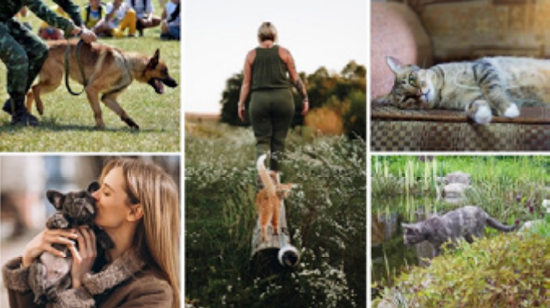S. Robertson
roduction
There are multiple causes of chronic pain in dogs and cats including but not limited to osteoarthritis, oral and dental disease, neoplasia and pain related to its treatment, persistent post-operative pain, and long-term dermatologic disease. Of these, the most common cause in both dogs and cats is osteoarthritis which is associated with pain and varying degrees of disability. Chronic pain is usually more prevalent in older pets but can affect any age group.
Advances in veterinary medicine have resulted in pets living longer and living with diseases that in the past were untreatable or surviving surgeries or trauma that would not have been previously attempted. As a result, more animals may be living with long-term pain. We must never lose sight of our duty to animals which is to preserve quality of life and we must ensure that our ability to make ethical and welfare decisions keeps in step with medical advances.
A good quote to keep us focused on our approach to treating animals comes from the physician Atul Gawande who states that “we’ve been wrong about what our job is in medicine. We think our job is to ensure health and survival. But really it is larger than that. It is to enable well-being.”10
Pain and Quality of Life
It is difficult to describe in words exactly what quality of life (QoL) is—it is subjective and unique to each individual. One approach is to ask, “how does the animal (or person) feel about their circumstances?” This must consider health, physical and mental states and in animals assessment requires input by proxy respondents. Pain can have a detrimental impact on QoL based on the following definition of pain; “pain is a distressing experience associated with actual or potential tissue damage with sensory, emotional, cognitive, and social components”.1
Comfort, which we can take to mean “absence of pain” or “pain which is within a tolerable threshold for the individual” features as an important domain in health-related quality of life (HRQL) assessments in dogs and cats (Figure 1).2-4
Figure 1. Key domains used for assessing HRQL in dogs and cats

The contents of our pain management toolbox are continuously expanding and contains both pharmacologic and non-pharmacologic tools. Despite these advances there are specific cases or a time in a specific patient that we can no longer control pain within a tolerable level for an individual. Pinpointing when we are at that point is essential for preventing unnecessary suffering. There are specific tools available for assessing pain related to OA in dogs and cats.5-8 However, pain should not be considered in isolation; it’s impact on QoL or its contribution to the overall wellbeing of the animal must be considered when comorbidities exist. For example, if a cat has OA and chronic kidney disease each will have an impact, and these may vary from day to day. It is important to assess QoL over time by keeping a diary or using an online tool (e.g., HRQL assessments by Vetmetrica).11 Mapping progression also helps with decision making.
The individuality of QoL adds to the complexity of assessing whether or not an animal is enjoying life. Just as with people what animals like to do varies. Some of us are happy and content doing very sedentary things such as enjoying being outdoors and reading a book, but others are only happy on an adventure that is physically demanding such as mountain climbing. The impact of pain and mobility impairment on these different individuals will be markedly different. Although we try to avoid anthropomorphism in veterinary medicine it is difficult; consider the impact of osteoarthritis on the following dogs and cats shown in Figure 2.
Figure 2. Images of dogs and cats with different lifestyles

In some cases, it is clear we should not assume certain things about animals. When the impact of osteoarthritis on cats’ lives was considered, the hypothesis was “that items contributing to QoL in cats are predominantly items requiring mobility.”9 In fact, when owners were consulted on what was important to their cat’s quality of life, 40% of items listed involved mobility, while 60% were “inactive” items, which resulted in rejection of the hypothesis.9
Euthanasia and Anticipatory Grief
“How we seek to spend our time may depend on how much time we perceive ourselves to have.” Atul Gawande.11 Once owners know that their pet has chronic pain or an incurable disease—the focus is on alleviation of pain, enhancing quality of life and dealing with comorbidities. But at this point they begin to understand that time with their pet is limited and as with people begin to wonder how they can make the time left the best it can be. This is also the time that anticipatory grief can surface. Anticipatory grief refers to a feeling of grief occurring before an impending loss; understanding this issue in human caregivers and those with sick parents, spouses and children is advancing, and its occurrence in pet owners is now recognized.12 Unlike most situations in humans, there is the added issue of discussing and performing euthanasia.
In my experience, creating so-called “Bucket Lists” can be quite powerful for owners. It reaffirms and strengthens the human-animal bond and gives the owners purpose and happy memories to focus on after they have said goodbye to their dog or cat. An example of a bucket list is shown in Figure 3.
Figure 3. One family’s bucket list for their dog Pete
Figure 3. One family’s bucket list for their dog Pete

Owners need our support and help with difficult decisions and we must guide them and be part of the decision-making team. This requires excellent communication skills, time and empathy. One think that makes a big difference to owners is how you phrase things (verbal priming). Here are some simple ways to make a positive impact:
asd

Euthanasia
Euthanasia is often thought of as a failure, but it should be looked at as a treatment option which is a unique gift that veterinarians can offer. Each decision to euthanize an animal will be different; factors to consider are the owner’s budgets which include financial, emotional, physical, and time. Euthanasia can be a planned procedure and it is always better to euthanize a day to early than a moment too late. In this situation the owners along with the veterinarian can decide where, when and how.
If we monitor HRQL and perform euthanasia well—i.e., truly provide a “good death” then life for a pet can be good from start to finish. This will reduce the owner’s grief and increase the likelihood of them becoming pet owners again.
References
1. Williams AC, Craig KD. Updating the definition of pain. Pain. 2016;157(11):2420–2423.
2. Reid J, Wiseman-Orr ML, Scott EM, Nolan AM. Development, validation and reliability of a web-based questionnaire to measure health-related quality of life in dogs. J Small Anim Pract. 2013;54(5):227–233.
3. Reid J, Wiseman-Orr L, Scott M. Shortening of an existing generic online health-related quality of life instrument for dogs. J Small Anim Pract. 2018;59(6):334–342.
4. Noble CE, Wiseman-Orr LM, Scott ME, Nolan AM, Reid J. Development, initial validation and reliability testing of a web based, generic feline health-related quality-of-life instrument. J Feline Med Surg. 2019;21(2):84–94.
5. Muller C, Gaines B, Gruen M, et al. Evaluation of clinical metrology instrument in dogs with osteoarthritis. J Vet Intern Med. 2016;30(3):836–846.
6. Hielm-Bjorkman AK, Rita H, Tulamo RM. Psychometric testing of the Helsinki chronic pain by completion of a questionnaire in Finnish by owners of dogs with chronic signs of pain caused by osteoarthritis. Am J Vet Res. 2009;70(6):727–734.
7. Klinck MP, Monteiro BP, Lussier B, et al. Refinement of the Montreal Instrument for Cat Arthritis Testing, for Use by Veterinarians: detection of naturally occurring osteoarthritis in laboratory cats. J Feline Med Surg. 2018:20(8):728–740.
8. Gruen ME, Griffith EH, Thomson AE, Simpson W, Lascelles BD. Criterion validation testing of clinical metrology instruments for measuring degenerative joint disease associated mobility impairment in cats. PloS One. 2015;10(7):e0131839.
9. Benito J, Gruen ME, Thomson A, Simpson W, Lascelles BD. Owner-assessed indices of quality of life in cats and the relationship to the presence of degenerative joint disease. J Feline Med Surg. 2012;14(12):863–870.
10. Atul Gawande, Being Mortal: Illness, Medicine and What Matters in the End, Metropolitan Books.
11. www.newmetrica.com/vetmetrica-hrql
12. www.lapoflove.com/Education/Anticipatory-Grief